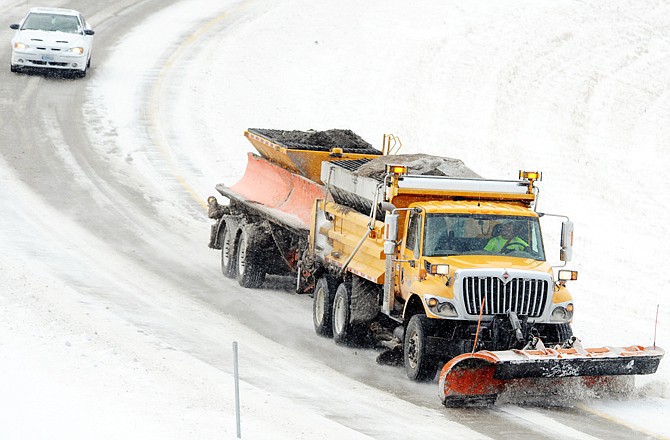Beet juice and dedicated drivers are part of what helps the Missouri Department of Transportation keep roads clear in winter, and the agency was already in gear Thursday, practicing for the months ahead.
MoDOT Central District Maintenance Engineer Jason Shafer said all of the districts in the state did "snow drills" Thursday - driving the routes trucks and plows will have in the winter.
Jason Lackman, of Centertown, is one of those drivers. Lackman said he's been driving a MoDOT plow since 1993, and he and another crew leader typically stay in Jefferson City to cover - or rather, uncover - about 30 miles of driving surface, plus shoulders and other surfaces.
For Lackman, that means U.S. 50 from Dix Road to Missouri Highway Patrol Troop F's headquarters at Shamrock Road, and then, he helps with roads such as routes D and T.
Shafer said the Central District is responsible for 11,300 miles of highway, spread across 18 counties and between 24 maintenance facilities, with 225 trucks for snow removal.
He added the Central District has 38,000 tons of salt stockpiled. The district used 30,000 tons last year.
"We're just wanting to hedge our bets. We figure that's a good insurance policy. We're highly optimistic that it's going to be a light winter, but we don't want to jinx ourselves by saying that," Shafer said.
He said it's uncertain what to expect this winter, but the worst is always planned for.
Speaking about public perception, Shafer said, "Our biggest challenge has always been that smaller snows seem like they're easier to clean up. It's not always the case, because you might get a low-intensity storm that you might get an inch of snow, but it takes 24 hours to get it. So, your roads are going to be slick, for you can figure a 24-hour time period. It takes a lot more material on your smaller snows than what it does (for) say 6, 8 or 10 inches of snow. (Less intense but longer-lasting storms) consume a lot more material. It takes more time to get it cleaned up, and there sometimes seems to be perception that, 'Hey, it's a smaller snow, shouldn't take that long to clean up, I can go.'"
"Anytime there's going to be snow flying, we want to encourage people to slow down or just even question the necessity of their trip," Shafer added.
Four-wheel drive is the answer to how a snowplow driver gets to work in a winter storm if it comes to that, though Lackman added he has a neighbor who cleans his driveway for him if he's at work.
MoDOT crews were already treating some road surfaces on sunny but cold Thursday, including on U.S. 50 - part of normal operations, and not drills, Shafer said.
He said bridge decks and other areas that easily develop ice get pre-treatment with a mix of beet juice and salt brine.
The beet juice comes from a sugar beet processor in Iowa, and though it smells terrible - like dirty feet and sewage, Shafer said - "it's a lot more environmentally-friendly," will be washed off with a quarter-inch of rain, is cheaper to get and doesn't corrode equipment.

